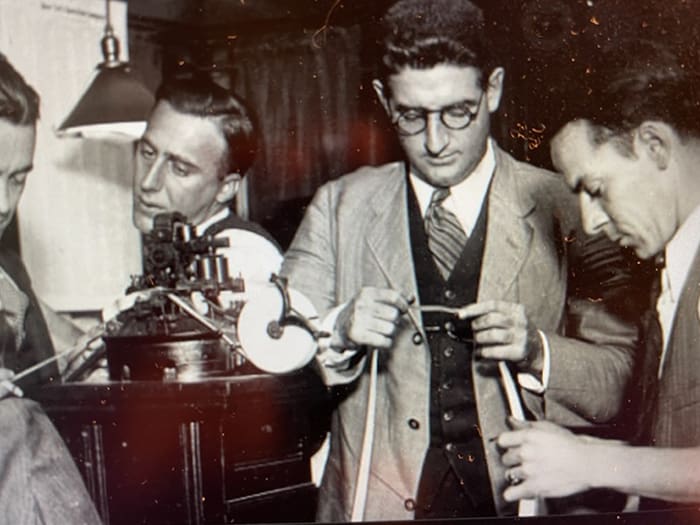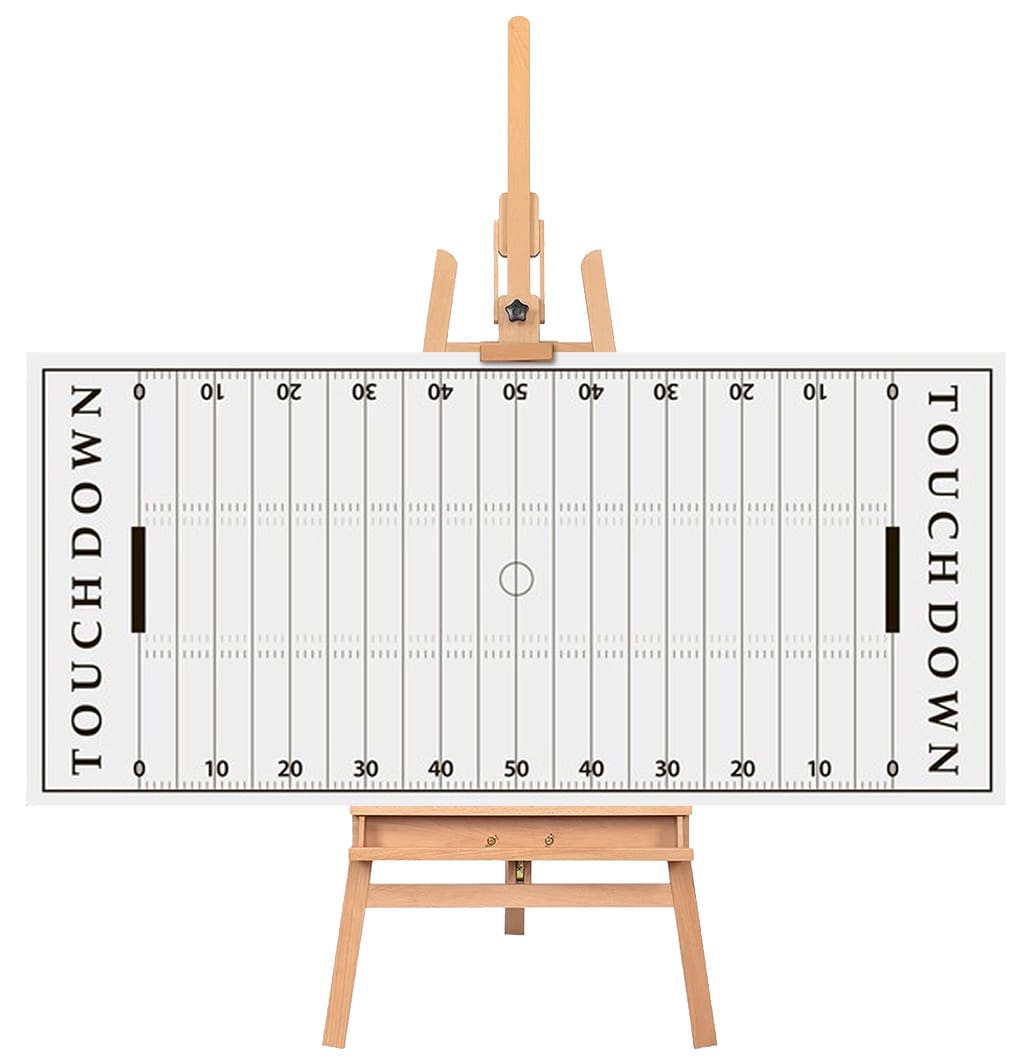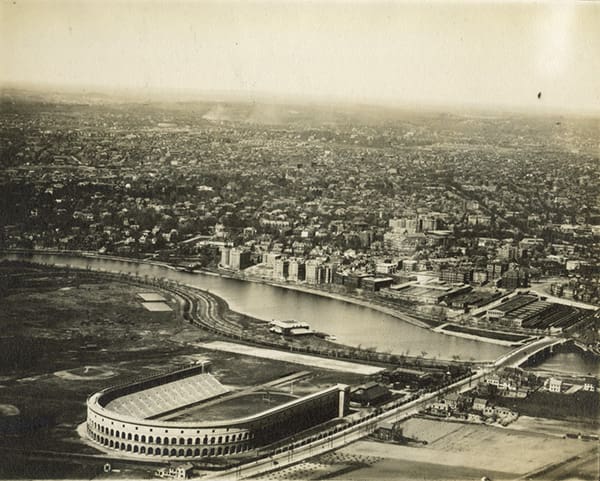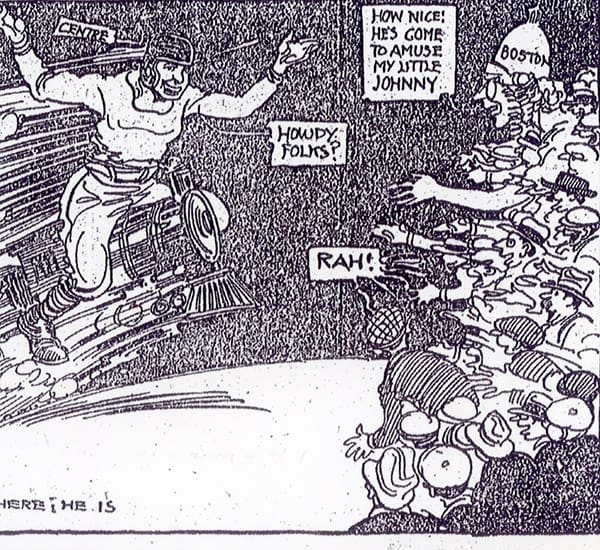Preparations for Harvard Intensity
Bo had seen Harvard beat Williams 38-0 while his teammates were toying with Transy. It was the first time he had ever experienced the vastness and grandeur of the beautiful, classical, horseshoe stadium across the Charles from the Harvard campus.
Williams had a quarterback named Ben Boynton who was a Walter Camp third team All-American the previous year. It was interesting for Bo to see a rival for honors in action, but the Crimson bottled up Boynton and the "Ephs"' offense.
( The unusual nickname of the Williams' teams was derived from a shortening of the first name of Ephriam Williams who first had the idea for founding a college in western Massachusetts.)
The win over Williams made Harvard 4-0, and interestingly, neither the Crimson nor the Colonels had given up a point. Obviously, something had to give.
Harvard 3 Holy Cross 0
Harvard 41 Maine 0
Harvard 21 Valparaiso 0
Harvard 38 Williams 0
Harvard was 9-0-1 in 1919 and had won 4 straight during the present season. Thus the stage was set. Harvard hadn't lost in the last 14 games. Centre had won 22 straight.
As the week of Monday, October 18 began, an article in the "Messenger" conveyed to its readers how the team and Danville were facing the upcoming contest.
COLONELS BEING GROOMED FOR EASTERN TILT
Man o' War could not have been groomed anymore carefully before his race with Sir Barton last week than the Centre Colonels in preparation for the Harvard game Saturday. (Man o' War beat Triple Crown winner, Sir Barton, by seven lengths in the Kenilworth Park Gold Cup in Windsor, Ontario. It was the great champion's final race, his 20th win in 21 starts, after which he was retired to stud at Faraway Farm in Lexington, Kentucky.)
Hour after hour, Coach Moran, Chief Myers and assistants Thornhill and O'Connor, along with trainers McDonnell and Caudill, are making every effort to prime the eleven for the greatest intersectional battle in the history of college football.
The team is progressing nicely and though members are saying little, their thoughts could not be bound in a thousand volume library. The new assistants, both 200 pounders, know their football as well as Dr. Redd, Centre professor of languages since 1881, knows his Greek, which in the polite verbiage of the bystander, is "sure covering a lot of territory. "
The coming game is being played on every street corner every hour of the day. Interest in the presidential race had been completely switched to Centre's chances against the Harvard Crimson. Enthusiasm is not confined to Danville and Boyle County, for reports from all over the state indicate that Kentucky athletic lovers are running on high and find it hard to wait for game time. "Play by play" will be called at Somerset, Lexington, Louisville, Franklin, Carlisle, Owensboro, Henderson, Ashland, and many other cities.
A quiz session was held last evening in the gym with mentors Moran and Myers at the blackboard. Plays were minutely detailed and each man was questioned as to his part in the formation. Skull practice is again scheduled for the next two days.
It is the tradition with Centre's teams to fight to the bitter end. That spirit was never manifested more than at Charleston, W.Va. last November. It is a general belief that Saturday's performance will eclipse even that record. The eyes of Kentucky and the South are leveled on the wearers of the Gold and White, and when the referee sounds the following interrogation, "Are you ready Captain Horween? Are you ready Captain McMillin?"- there will be many who will spasmodically hold their breaths for the first return.
When it was mentioned that there was to be "play by play" regarding sporting events of the era, further explanation is in order. Prior to radio coverage, which was soon to come, the telegraph lines were utilized to pass on information about sporting events, including football games.
An individual would sit in the press box or somewhere atop a stadium equipped with a Western Union telegraph machine. He would type a short description of the play.

Covering a game telegraphically
Then he would tap out something like- Roberts around end for 5 STOP Harvard player down STOP Time called Harvard STOP
The reason that there would be such short sentences is that each word cost a certain sum as did punctuation marks. However, "STOP" was free.
At the receiving end of the telegram the receiver would read the message and relay it to his listeners. If there were just a small group like in a particular brokerage office which was "wired," that would be all that would usually be conveyed.

Receiving the results
However, often the "broadcast" would be in a larger location like a theatre or hotel ballroom where a special wire had been leased for the game and the whole event would be quite a production.
An announcer would holler out the message for everyone to hear and a chalkboard would be set up so that the ball could be followed on the "field."

Setup so that the action could be followed on the "field" by placing a mark on the board where the ball was after each play
The announcer may embellish the action after receiving the message "Roberts around end for 5" by saying something like, "Roberts streaks around the right end running hard before being tripped up after gaining 5 yards."
Before radio, this was as close to real-time coverage as was available.
In Danville, both the "Messenger" and "Advocate" announced that they were going to offer "play by play." The chief of police said he'd approved roping off Main Street between Third and Fourth to accommodate the crowds. The two biggest hotels in Lexington, the Phoenix and Lafayette, advertised in the local papers that they were "wired." In Louisville, there was to be a "broadcast" from in front of the Hay hardware store, and from the stages of both the Strand and Ben Ali theaters.

Advertising the availability of the game being "broadcast" by "leased wire"
Besides the skull sessions held by the coaching staff, captain and traveler Bo was given considerable time to describe what he had seen at the game between Harvard and Williams. Bo had a notebook in which he'd constantly written while sitting up in Harvard Stadium, and refined on the long train ride from Boston. He would draw an offensive lineup and the resultant play on the board, and the coaches would discuss how to defense it. Another, and still another play-"Sully, if they line up like this, you..... "
"Bill, what should you expect if you see this formation?"
Bo would draw different Harvard defensive schemes.
"Here's where they may have a weakness if they spread out like this. It would be a good time to take it right over the left tackle."
"We've got to play smart. We can't beat ourselves. We have to constantly think, to analyze."
Other than doing laps in order to stay in shape, there was little time spent on the field. It was skull session after skull session. It was pep talk after pep talk. It was a time once again to believe. It was a time to achieve. It was a time to succeed in the greatest event that anyone connected to the team and to Centre College had ever experienced.
Ticket sales were far beyond the greatest expectations as the game day approached. As immense as Harvard Stadium was, it was announced that an additional 4000 seats were being constructed in the north end zone which wasn't closed, to be sold for $1.50.

Harvard Stadium in its normal configuration with no end zone seats which were added when additional capacity was required for the Yale and Princeton games, and now for Centre in 1920. The Stadium sits just south of the Charles River in the Allston neighborhood across from Cambridge. The Anderson Bridge crosses over the Charles and was financed by Larz Anderson in memory of his father, Nicholas Longsworth Anderson.
The end zone seats had been present in 1919 because Yale was playing in Cambridge that year. They were removed after that game as it hadn't been felt that they would be needed again until the Princeton game on November 6 when they were scheduled to be reassembled. Now, with the huge demand for seats, the wooden bleachers were trucked to the Stadium and workers were getting them ready for Centre's appearance.
Additionally, box seats, 5 rows deep, were being constructed on the west side of the field below the permanent, concrete part of the horseshoe.
The gate receipts were announced at $72,000, and major numbers of orders were still coming in. One newspaper reported that an individual in the Harvard athletic department stated that 75,000 tickets could be sold if they were available.
Other than Yale and Princeton, no school had come close to having the appeal as Centre in Boston. Brown, Penn State, Virginia, and North Carolina couldn't come close to filling the Stadium. In the last intersectional game for the Crimson, the 1914 game with an excellent Michigan team, only 23,213 fans were in attendance, respectable, but just half the capacity of the Stadium.
Centre had been guaranteed $6,000.00. The game was going to be a huge financial success for Harvard. Certainly, this was important to Howard Reynolds. His goal of having intersectional games become regular parts of the schedules of the eastern colleges didn't have a chance to float if it wasn't shown that such contests could be big money makers.
The Boston papers began giving major coverage to the game. Unlike today, when many metropolitan areas have perhaps one, or two major dailies, Boston was the home of multiple papers in 1920. There was the "Post," the "Globe," and "Herald."
There was a Boston "American," the "Traveler," and the "Daily Advertiser."
This photograph was one of many published by the Boston press in advance of the game.

Left to right, top- George Chinn, Hump Tanner, Sully Montgomery, Red Weaver, kicking.
Left to right, bottom- Tom Moran, Uncle Charlie, Bo McMillin, running
There was a cartoon printed by Donelan which proposed what Danville would look like if Centre beat Harvard.

Cartoon by Charles Donelan, a sportswriter and cartoonist with the Boston "Traveler"
Another showed a Centre player taking the train to come to amuse the Bostonians.

"My little Johnny"- John Harvard
The "Post" published a large cartoon by Collier, a noted Eastern artist. Centre's team was depicted as an animal that "eats them alive," chewing up the Harvard squad. Another panel had the Colonels in circus-like wagons being transported from the train to the football field. The players were represented as having long, shaggy hair, with big mouths and prominent teeth able to chew up anything in sight. Still another area in the cartoon had a mother who was trying to get her child to quit crying. As a final resort, she threatened to send for a Centre player and the chap immediately goes silent.
Wednesday, October 20, was the last day of practice. The team actually took to the field in sweat suits and ran through some plays, perfecting timing, showered, broke for dinner, and then it was back to the drawing board for one more session. After the last diagram had been reviewed, the players walked the few blocks to the downtown, Boyle County courthouse.
It was a cool, crisp night as a huge throng made its way to the plaza around the 1862 government building, its architecture inspired by studying the great buildings designed by Christopher Wren. Spotlights flooded the area. All of the students and faculty from K.C.W. were in attendance, as were the faculty members and students of Centre. Local citizens of Danville and from out in the county swelled the crowd to over 1,000. At exactly 7:30, cheerleaders George Swinebroad and Edwin Thomas began the pep rally by leading the cheers.
The members of the team were brought up on the wooden stage which had been constructed on the courthouse steps and asked to make a speech, and when each finished, a cheer resonated through the downtown, echoing off the walls of the nearby buildings. Many of the players ended their comments by assuring the onlookers that they had every intention of representing Centre and Danville by fighting as hard as they could, and-"We intend on winning!"
The Chief and Uncle Charlie gave brief speeches, thanking everyone for the loyalty shown to "our boys." Both Myers and Moran praised the spirit of the team.
"They have great fellowship and conduct themselves as brothers."
After the pep rally wound down, the coaches led the players back to the gym to make certain that each member had packed all of their necessary equipment. Several of the Colonels came over to Red Weaver and pretended to search his bag to make certain that he had included his helmet. Other than ribbing Weaver, the expressions of each of the Colonels reflected a calm determination.
Then it was back to the dorm or their rooms in town for one last night's sleep before beginning the venture which each of the wearers of the Gold and White, which each of the coaches and faculty members, that all of Danville and so much of Kentucky, had dreamed about and made plans for since the telegram arrived from Harvard the previous December 8th.
It was, "ON TO HARVARD!!"
